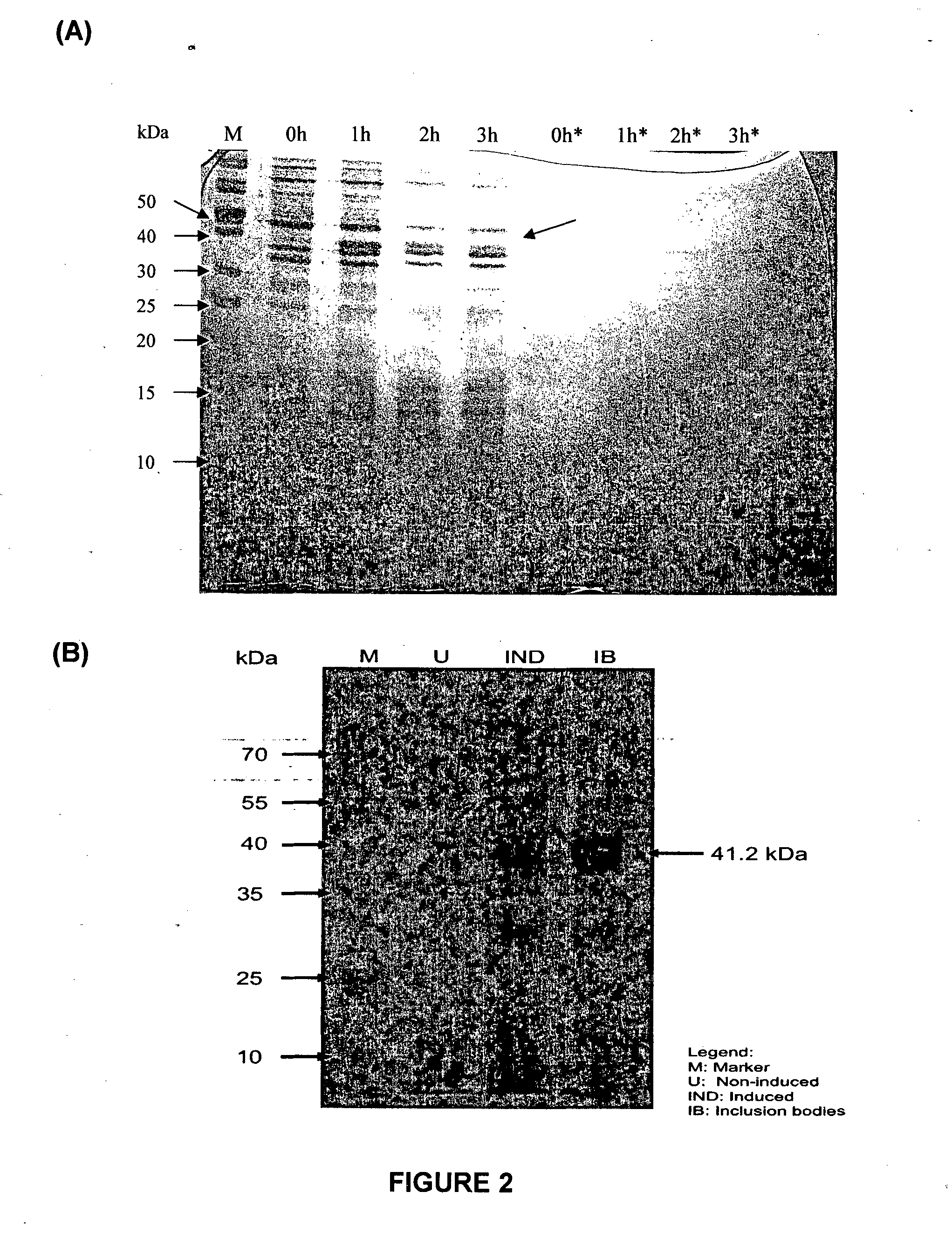Rapid specific pathogen free animal
a pathogen-free, specific technology, applied in the direction of animal/human proteins, mammal proteins, enzymes, etc., can solve the problems of spf animals, spf farmers pay large amounts of money annually, and spf animals are both dangerous to the health of humans and/or human beings, and achieve the effect of optimal effectiveness
- Summary
- Abstract
- Description
- Claims
- Application Information
AI Technical Summary
Benefits of technology
Problems solved by technology
Method used
Image
Examples
example 1
Construction and Design of Expression Vector
[0122]The gene encoding RetroMAD1 A-B-C with SEQ ID NO:1 was synthesized and cloned into backbone of vector pGA4 at the KpnI / SacI site by contract service (GeneArt AG, Germany). The expected product size was 1140 bp, which encoded a 379 amino acid and an expected size of 41.2 kDa. The polynucleotide sequence and the translated polypeptide sequence are shown in FIG. 1 from PCT. The gene was sub-cloned into a pET expression vector (Novagen), pET-26(b) at the NcoI / HindIII sites. Kanamycin was used as a marker for selection and maintenance of culture purposes. This vector was inducible under the addition of isopropyl-beta-D-thiogalactopyranoside (IPTG). The plasmid, pRMD1 was then transformed into BL21(DE23) cells (Novagen) and plated on a selective media with Kanamycin.
Expression of RetroMAD1 from E. coli
[0123]One recombinant clone was grown in 10 ml of LB Bertani (DIFCO) medium, supplemented with 30 μg / ml kanamycin, at 37° C. overnight. Thi...
example 2
Elimination of Hepatopancreatic ParvoVirus (HPV) from Shrimp
Shrimp Culture and RetroMAD1 Treatment
[0127]Naturally infected HPV shrimp (150 pieces) was obtained from a local aquarium shop. Twenty pieces of of randomly selected shrimp was selected for DNA extraction to confirm for HPV (Hepatopancreatic Parvo Virus) infection in the population. For the experiment, 56 shrimps were reared in two 20 liters tank (24 each) containing de-chlorinated fresh water equipped with aeration. Water exchange was carried out at 20% every two days. Shrimps were acclimatized for one week before the experiment.
[0128]For the experiment both tanks were given 0.25 mg of feed daily, divided into 3 meals. Treated tanks were a given a dose of 25 ug of RetroMAD1 absorbed into the commercial feed for each meal for four days while the control was given sterile water absorbed into the feed. After the end of the experiment (day 4), 24 pieces of shrimp were still alive in the treated tank while 23 pieces were still ...
example 3
Effect of RetroMAD1 on WSSV-Infected Shrimp
[0131]White Leg Shrimp Penaeus vannamei (36 pieces) at an average of 8.0±0.5 grams were used in this experiment they were obtained from pond-reared from SPF (specific pathogen free) post-larvae obtained from commercial hatcheries. Treated sea water was obtained from the hatchery. Cultures of healthy shrimp were performed in a recirculation system (equipped with filter and aeration) with a salinity of 28-32 ppt in a bio-secure laboratory at 28° C. They were acclimatized 1 week before the infection experiment. Two groups of 18 prawns were reared in a 90 liter tank with and individual filter (FIG. 4).
WSSV Infection
[0132]Prawns were orally challenged by feeding frozen flesh from WSSV-PCR positive prawns obtained from a recently WSSV-killed pond at approximately 5% of body weight on the first day. The next day, were given RetroMAD1 at a concentration of 0.1 mg / g body weight by coating it into a commercial feed. They were given the ...
PUM
| Property | Measurement | Unit |
|---|---|---|
| Current | aaaaa | aaaaa |
| Current | aaaaa | aaaaa |
| Current | aaaaa | aaaaa |
Abstract
Description
Claims
Application Information
 Login to View More
Login to View More - R&D
- Intellectual Property
- Life Sciences
- Materials
- Tech Scout
- Unparalleled Data Quality
- Higher Quality Content
- 60% Fewer Hallucinations
Browse by: Latest US Patents, China's latest patents, Technical Efficacy Thesaurus, Application Domain, Technology Topic, Popular Technical Reports.
© 2025 PatSnap. All rights reserved.Legal|Privacy policy|Modern Slavery Act Transparency Statement|Sitemap|About US| Contact US: help@patsnap.com



